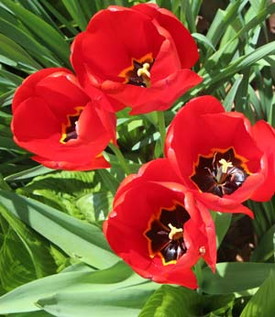The season changes, but don’t mope and brood. Instead do something that cheers the heart now … and again next spring. Plant bulbs. Come April, one can never have too many bulbs.
 1. BULBS CAN BE PLANTED until the ground freezes. Daffodils should be planted first, ideally in September, because they need warm soil to start their root growth. Also grape hyacinths (muscari) should be planted early because they like to send up green spiky foliage in fall. Tulips don’t care when.
1. BULBS CAN BE PLANTED until the ground freezes. Daffodils should be planted first, ideally in September, because they need warm soil to start their root growth. Also grape hyacinths (muscari) should be planted early because they like to send up green spiky foliage in fall. Tulips don’t care when.
2. ANIMALS are a problem because they eat the flowers just as they are opening, especially the tulips. There is nothing so anger producing as a beautiful tulip cut off at the top and lying on the ground. I spray the flowers with a bitter tasting animal repellant called Ropel.
Where animals are a problem, plant daffodils, which contain toxic substances. The early blooming blue scilla also seems to survive, but the rest get the Ropel treatment. Also various animals dig up the bulbs. One possible help is to put a section of chicken wire over the top of the planting area.
3. SERIOUS GARDENERS plan for a succession of bloom in spring. When buying bulbs at a good supplier, they usually say "Early" or "Midseason" or "Late" for flowering time. Incidentally, the bargain bulbs one can buy at outlets are always second grade. And you do get what you pay for.
The early bulbs are most cherished. They are scilla, crocus, grape hyacinths, and early tulips (especially Red Emperor) and early daffodils. Mid season has the main selection of daffodils and tulips. There are many late flowering varieties as well, but by then, other blossoms and perennials capture one’s eye.
 A nice trick is to plant tulips in a bunch (or bouquet) and plant grape hyacinths between the bulbs or around the edge. As the tulip foliage yellows (after the flowers fade) the green grape hyacinth foliage will hide it. Another trick is to plant pansies in spring to hide the yellowing bulb leaves.
A nice trick is to plant tulips in a bunch (or bouquet) and plant grape hyacinths between the bulbs or around the edge. As the tulip foliage yellows (after the flowers fade) the green grape hyacinth foliage will hide it. Another trick is to plant pansies in spring to hide the yellowing bulb leaves.
4. TO GET BULBS TO REPEAT FLOWER in future years, their foliage must be allowed to grow until it yellows and falls. Not all bulbs will repeat, and the old classics that do are labelled "Repeaters". (Obviously)
For those repeaters, fertilize heavily just after flowering, and pick off the dead flower heads. Deep planting also encourages bulbs to repeat flower ( 3x the height of the bulb, and at least 8 – 12" deep for daffodils.) Shallow planted bulbs have a tendency to split into smaller bulblets which just send up foliage but do not flower. I have tried to grow these as a crop, like the Dutch do, but have never gotten them to flower again.
5. MOST IMPORTANT PLANT BULBS WHERE YOU CAN SEE THEM from your windows, especially where you eat breakfast. They start flowering very early in spring and so they must be close at eye range to be properly enjoyed. And enjoy them you will, if the rotten squirrels and deer don’t find them first.
Ruth S. Foster is a Landscape Designer and Arborist. More info can be found on her web site: mothersgarden.net.
Credit: www.mothersgarden.com




























